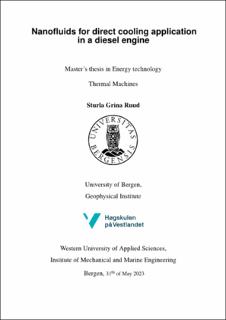Direkte bruk av nanofluider som kjølevæske i en dieselmotor
Master thesis

View/
Date
2023-06-01Metadata
Show full item recordCollections
- Master theses [105]
Abstract
The work carried out in this thesis is the characterization and investigation of carbon- based nanofluids as a potential engine coolant for a single-cylinder diesel engine. Car- bon black particles could be sufficiently stabilized with a 1:10 wt. ratio of PVP. Given a 1 hour sonication time. This was done for samples containing 0.5wt.%, 1wt.%, 2.5wt.%, 5wt.%, 7.5wt.% and 10wt.% nanoparticles. The physical properties of the different nanofluid samples were studied. This includes experimental testing for sta- bility to static and thermal load. Which was quantified using Ultraviolet visible spec- troscopy and particle size distribution. How particles and basefluid influences nanofluid viscosity was determined experimentally through viscosity measurements. Addition- ally, these data were further investigated using Brinkman’s and Einstein’s equations. Nanofluid’s thermal conductivity was decided by testing common effective medium theories to previous measurement data and new measurement data using a transient hot wire. The nanofluid properties were used to evaluate what fluids should be used as coolants in the compression-ignited engine. It was found that there was little change when considering the general trend for static stability over two weeks. Thermal sta- bility was however difficult to characterize, and the reason for this is not known. Ad- ditionally, thermophysical properties were used to determine the relative effectiveness of different samples of nanofluids compared to water, using so-called "figure of merit" equations. This showed that concentrations 2.5wt.% and 0.5wt.% carbon black had the best properties as an engine coolant. The heat transfer of these nanofluids was com- pared to the rate of heat transfer of water, and ethylene glycol in water at flow rates of 3, 4, and 5 liters per minute. No clear trend was found for the nanofluids, and at this time is thought to offer little benefit as an engine coolant. However, more work is needed on the subject.